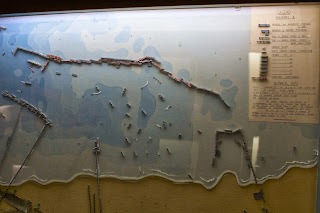Independence Missouri seems the perfect place for Truman’s
library. It’s now a suburb of Kansas
City, with the ability to see the skyline in the distance from it’s highest point.
It’s on the edge of being modern, but still traditional.
The museum has been fortunate to have a recent renovation
within the last ten years. Displays and facts are presented in a very
interesting and digestible format. The second room one enter after the welcome
movie, shows a series of newspaper front pages. It’s clear to see that from the
time FDR passes and Truman takes office, to the time of VJ Day is a few mere
months. This is the power of presidential momentum. Over thirteen years of work
from FDR is enjoyed over the first few months of Truman’s term in office. He
didn’t invest in the bomb, know about it’s construction, or all of the
tribulations raised by those averse to its use, until it came time to make a
choice to use it. Which he did, twice.
The highly trusted adviser George C Marshall had a plan for
the Berlin airlift. He knew how to prepare, execute, and make it happen. Harry
got to tell him to do it. There were years of policy and negotiation about
civil rights, economy, and other domestic policy which Truman allow to happen
when serving out the last FDR term.
When it came time to get reelected, it was close. Under his
own command of design things became shaky. Of the Fair Deal, only two items
were enacted, and two more in part. Foreign policy choices in APAC had long
lasting impact on the following five Presidents. A policy of containment with
the Soviet Union was not realized during his time in office as he chased hot
spots across the globe.
Truman came to power with great assistance of a local Kansas
City party chief Tom Pendergast. He got to the Senate with this backing, a
black mark that stayed with him until being nominated for Vice President.
I may not be the first person to be disappointed in Truman.
While the museum is a good quality, there is nothing here that is
inspirational. His rise seems the most political of opportunity and
circumstance. It was surprising that the people writing his legacy would spend
so much time justifying his decision to dismiss Douglas McCarthy while fighting
the Korean War. The trial of Alger Hiss, the rise of McCarthyism, and his break
with the Southern Democrats are topics that are in desperate need of review.
Information on these three areas fall flat. I find it funny to have enjoyed the
Nixon and Hoover museum more, finding more about these individuals’ lives or
actions that I could relate to.



























































